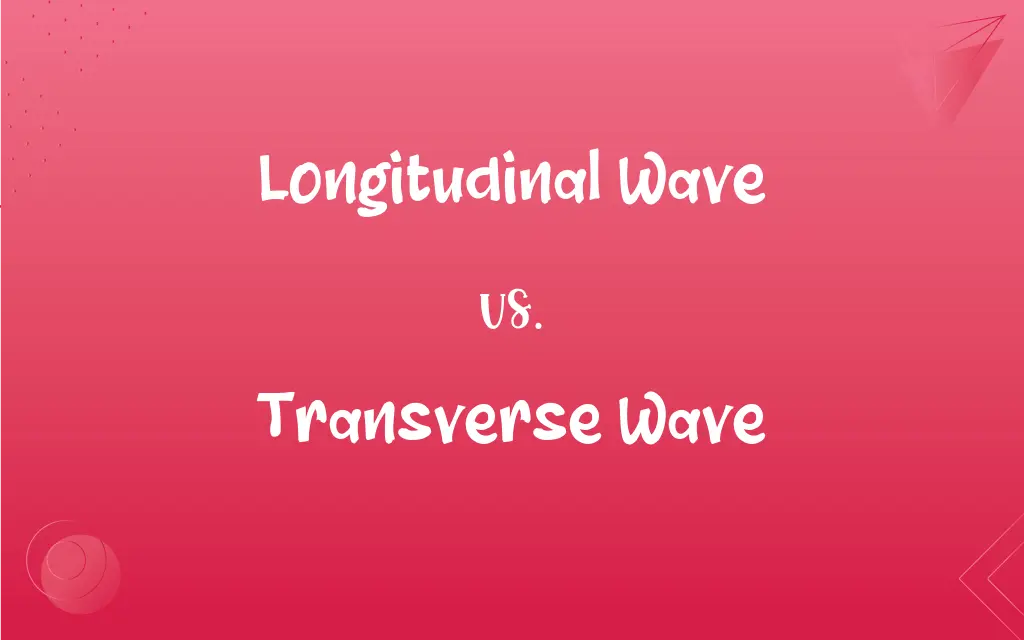Longitudinal Wave vs. Transverse Wave: What's the Difference?
Edited by Janet White || By Harlon Moss || Updated on July 12, 2024
Longitudinal waves have oscillations parallel to their direction of travel; transverse waves have oscillations perpendicular to their travel direction.

Key Differences
Understanding the contrasting natures of longitudinal and transverse waves requires recognizing their distinctive modes of particle oscillation. In a longitudinal wave, particles of the medium through which the wave is traveling oscillate parallel to the direction of energy transport, characterized by compressions and rarefactions. Transverse waves, alternatively, feature particles oscillating perpendicular to the wave's direction of travel, creating crests and troughs that form a recognizable wave pattern, a variance stark against the compact and stretched phases seen in longitudinal waves.
These two wave types are integral in various scientific and technological applications, for instance, sound waves travel as longitudinal waves, moving air particles back and forth in the direction the sound is traveling, whereas light typically travels as transverse waves, with electric and magnetic fields oscillating perpendicular to the direction of the wave's movement.
Moreover, the medium through which the waves travel often influences their nature; longitudinal waves require a medium to travel through, including sound waves through air or pressure waves through a slinky, while transverse waves can traverse both media and vacuums, exemplified by electromagnetic waves like light.
Furthermore, the analytical study of waves in physics employs various mathematical and conceptual models, accommodating the differential behaviors of longitudinal and transverse waves, like the distinctions in their graphical representations and behavior through various media, thus affirming the necessity of recognizing their divergent characteristics.
Comparison Chart
Particle Motion
Parallel to wave direction
Perpendicular to wave direction
ADVERTISEMENT
Examples
Sound waves, seismic P-waves
Light waves, waves on a string, seismic S-waves
Wave Components
Compressions and rarefactions
Crests and troughs
Medium Requirement
Requires a medium (cannot travel through a vacuum)
Can travel through a vacuum (e.g., electromagnetic waves)
Speed Determination
Influenced by medium density
Influenced by medium's rigidity and tension
Longitudinal Wave and Transverse Wave Definitions
Longitudinal Wave
A wave with oscillations parallel to its direction.
Sound travels as a longitudinal wave through the air.
ADVERTISEMENT
Transverse Wave
A wave capable of traveling through a vacuum.
Unlike sound, a transverse wave like light can traverse the vacuum of space.
Longitudinal Wave
A wave requiring a medium for transmission.
A longitudinal wave cannot propagate in a vacuum since it needs a medium.
Transverse Wave
A wave with oscillations perpendicular to its direction.
Light propagates as a transverse wave.
Longitudinal Wave
A wave exhibiting areas of compression and rarefaction.
In a longitudinal wave, you can observe compressed and rarefied sections.
Transverse Wave
A wave delineated by crests and troughs.
The transverse wave in the rope displayed clear crests and troughs.
Longitudinal Wave
A wave that impacts particle spacing.
Longitudinal waves cause particles to be closely packed in some regions.
Transverse Wave
A wave often related to electromagnetic phenomena.
Radio waves, being electromagnetic, manifest as transverse waves.
Longitudinal Wave
A wave affecting pressure in a fluid.
In gases, a longitudinal wave results in alternating high and low pressure.
Transverse Wave
A wave where particle displacement is orthogonal to wave direction.
In a transverse wave, particles move at right angles to the wave direction.
FAQs
What is a longitudinal wave?
A longitudinal wave is a wave in which particles of the medium move in a direction parallel to the wave's direction of travel.
How do longitudinal waves differ from transverse waves?
In longitudinal waves, particle movement is parallel to the wave direction, while in transverse waves, it's perpendicular.
Are longitudinal waves visible?
Generally, no, but the effects or results of these waves, like sound, can be sensed.
What's an example of a longitudinal wave?
Sound waves in the air are a primary example of longitudinal waves.
Do transverse waves always require a medium?
No, for instance, electromagnetic waves (like light) are transverse and can travel through a vacuum.
What are the compressions and rarefactions in a longitudinal wave?
Compressions are areas where particles are closest together, and rarefactions are areas where they are spread out.
What is polarization related to transverse waves?
Polarization describes the orientation of oscillations in space. Only transverse waves can be polarized.
Can longitudinal waves travel in a vacuum?
No, they require a medium, which is why sound (a longitudinal wave) doesn't travel in space.
How do frequency and pitch relate in sound, a type of longitudinal wave?
Higher frequency means a higher pitch in sound.
How is wavelength measured in a longitudinal wave?
It's the distance between two consecutive compressions or two consecutive rarefactions.
Are seismic P-waves longitudinal?
Yes, P-waves (primary waves) in earthquakes are a type of longitudinal wave.
What is a transverse wave?
A transverse wave is a wave in which particles of the medium move in a direction perpendicular to the wave's direction of travel.
Can transverse waves travel in a vacuum?
Yes, light is a transverse wave and it can travel through a vacuum.
How do transverse waves differ from longitudinal waves?
In transverse waves, particle movement is perpendicular to the wave direction, while in longitudinal waves, it's parallel.
Are seismic S-waves transverse?
Yes, S-waves (secondary waves) in earthquakes are a type of transverse wave.
How do particles move in a longitudinal wave?
Particles oscillate back and forth along the direction of the wave's propagation.
What's an example of a transverse wave?
Light waves and radio waves are examples of transverse waves.
What is amplitude in a transverse wave?
Amplitude is the maximum distance the particles move from their rest position.
How is wavelength measured in a transverse wave?
It's the distance between two consecutive peaks or troughs.
How do particles move in a transverse wave?
Particles oscillate up and down or side to side, perpendicular to the direction of the wave's propagation.
About Author
Written by
Harlon MossHarlon is a seasoned quality moderator and accomplished content writer for Difference Wiki. An alumnus of the prestigious University of California, he earned his degree in Computer Science. Leveraging his academic background, Harlon brings a meticulous and informed perspective to his work, ensuring content accuracy and excellence.
Edited by
Janet WhiteJanet White has been an esteemed writer and blogger for Difference Wiki. Holding a Master's degree in Science and Medical Journalism from the prestigious Boston University, she has consistently demonstrated her expertise and passion for her field. When she's not immersed in her work, Janet relishes her time exercising, delving into a good book, and cherishing moments with friends and family.































































